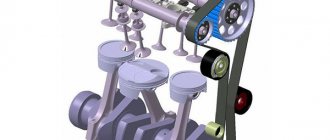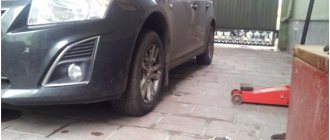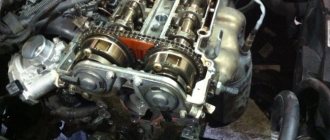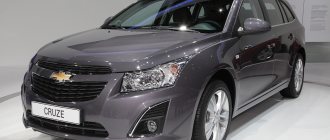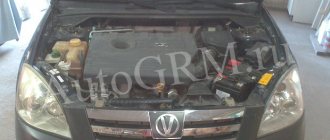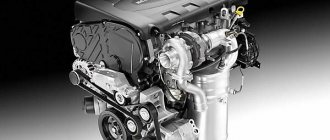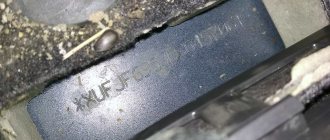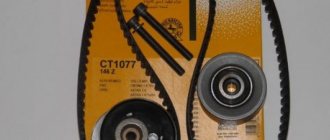Every car enthusiast who has at least a little idea of the structure of a car knows how important such a part as a timing belt is. Yes, depending on the design of the car, it may have a belt or chain drive for the gas distribution mechanism.
But because We are considering a Chevrolet Cruze, then we will only talk about belts. It is in plural quantities, because there are several modifications of the Chevrolet Cruze:
- with a 1.6 engine and a power of 109 hp. (index - LXT/F16D3);
- with a 1.6 engine and a power of 124 hp. (index - LDE/F16D4);
- with a 1.8 engine and a power of 141 hp. (index - 2H0/Z18XER).
It is worth noting that the process of replacing a belt on a car with a 1.6 engine and a power of 109 hp (LXT from 2010) differs from the operation of changing the timing belt on a car with a 1.6 engine and a power of 124 hp. (LDE). Therefore, you should be extremely careful both when purchasing a belt and the accompanying kit, and directly during the replacement process.
Nuances and regulations for replacing the timing belt
First of all, car enthusiasts need to know at what mileage it is necessary to change the timing belt and whether it will be necessary to replace any additional units.
So, on a Chevrolet Cruze with a 1.6 internal combustion engine and a power of 109 hp. (LXT/F16D3)) timing belt replacement period is 60,000 km. What many car enthusiasts often forget about. In practice, in the harsh conditions of the Russian Federation, the timing belt on a Cruise with an internal combustion engine (LXT) runs about 55,000 - 65,000 km.
IMPORTANT! In addition, when replacing the timing belt on a Cruise with a 1.6 LXT engine, you will also need to replace the water pump, which cannot be replaced without removing the timing belt.
For Chevrolet Cruze cars with 1.6 (LDE/F16D4) and 1.8 (2H0/Z18XER) engines, the timing belt replacement schedule is 150,000 km. In practice, the timing belts on these cars last a little less than the stated period, especially with an aggressive driving style. Therefore, it is worth replacing the timing belt already at mileages of 100,000 - 120,000 km.
Do not delay replacing the timing belt, because the consequences can be extremely sad. So, if the timing belt breaks, a loud noise will appear under the hood, and the car will immediately stop moving and stall. In this case, expensive repairs are guaranteed.
If we talk about other nuances, then we should focus on the fact that in addition to replacing the timing belt itself, it is also worth replacing the accompanying elements - tension rollers. Usually they come complete with a timing belt.
Service
Changing the oil in the Chevrolet 1.8 F18D4 engine.
On a Chevrolet Cruze and Opel Mokka with a 1.8 F18D4 (141 hp) engine, change the oil every 15 thousand km or 12 months.
The engine contains 4.5 liters of oil. When changing oil with a filter element, you will need 4.1-4.5 liters, without a filter - about 4 liters. Oil type: 5W-30, 5W-40, 0W-30 and 0W-40 (low temperatures), class - GM-LL-A-025. The approved oil is GM Dexos2. Replacing the timing belt for Chevrolet 1.8 F16D4 Cruze.
Once every 100 thousand km you need to check its condition.
The timing belt and rollers are replaced every 150 thousand km (otherwise the belt will break and the valve will bend). Change spark plugs every 60 thousand km. Spark plugs NGK ZFR6U-11. The Chevrolet 1.8 air filter
must be replaced after 50 thousand km of service.
to replace the coolant in the 1.8 F14D4
every 240 thousand km or 5 years (for Russian Federation conditions it is better once every 2 years). Fill with GM Dex-Cool antifreeze.
The surface of the toothed part of the belt should not have cracks, undercuts of teeth and separation of fabric from rubber, and the reverse side of the belt should not have wear, exposing the cord threads, and signs of burning. There should be no delamination or fraying on the end surfaces of the belt. If there is damage, the belt must be replaced. The belt must also be replaced if traces of oil are found on it (before replacing the belt, the cause of its oiling should be eliminated) or when replacing a faulty belt tension or guide roller.
Once the mileage reaches 150 thousand km, the belt must be replaced, regardless of its condition.
We carry out the work with an assistant on an inspection ditch or overpass.
We start by removing the protection of the power unit.
From the bottom of the car, using a 13mm head, unscrew the four bolts securing the power unit protection to the front suspension subframe.
We remove the power unit protection, supporting it with an adjustable stop.
We take out two pistons that simultaneously connect the shield and the right wheel liner.
Using the “8” head, unscrew the three self-tapping screws securing the shield to the subframe.
By sliding the right shield down, we remove it from under the wheel arch liner and remove it.
We unscrew the screws securing the fender liner of the right front wheel to the front bumper and fender and remove the pins securing the front part of the fender liner to the body, bend the front part of the fender liner and place it behind the brake disc.
To check the condition of the belt, use the E-10 head to unscrew the two screws securing the upper timing cover.
Remove the cover.
By turning the E-18 head the crankshaft clockwise by the screw securing the auxiliary drive pulley,..
...we assess the condition of the timing belt.
The operation of replacing the timing belt is quite complicated. At dealer authorized services, when replacing a belt, special tools and devices are used to set the engine valve timing. Therefore, we recommend that only an experienced performer with the appropriate skills in repairing modern engines repair the belt independently.
To replace the timing belt, remove the auxiliary drive belt...
To access the timing belt, the right power unit support must be removed.
We install a height-adjustable stop through a wooden block under the engine oil pan.
Remove the air filter.
Using a 15mm socket, unscrew the two bolts securing the right power unit support to the side member, the three bolts securing the support to the engine bracket and the nut securing the support to the body mudguard.
We remove the support from the engine compartment.
Right power unit support.
To access the ends of the camshafts, remove the cylinder head cover.
By pulling up, remove the casings of the engine management system wiring harnesses from the cylinder head cover holders.
We move the spring clamp of the tip of the crankcase ventilation tube.
Remove the tube tip from the cylinder head cover fitting.
Using the E-10 head, unscrew the 11 screws securing the cylinder head cover.
Remove the cylinder head cover.
For clarity, we show further operations on a dismantled engine.
Before removing the belt, set the crankshaft and camshafts to the TDC (top dead center) position on the compression stroke of the first cylinder.
To do this, turn the crankshaft clockwise by the screw securing the auxiliary drive pulley until the mark on the auxiliary drive pulley coincides with the mark on the lower timing cover.
In this case, the grooves made on the shanks of both camshafts should be located parallel and almost at the same level with the surface of the cylinder head adjacent to the cylinder head cover.
If the grooves on the camshaft shanks do not occupy the specified position, turn the crankshaft one more turn (360º) clockwise and again check the correct installation of the crankshaft and camshafts.
Using the E-18 head, unscrew the screw securing the auxiliary drive pulley. In order to keep the crankshaft from turning, we place stops under the car’s wheels, engage fifth gear in the gearbox and ask an assistant to firmly press and hold the brake pedal.
If it was not possible to unscrew the pulley mounting screw in this way, then, having unscrewed the two bolts with a 15mm head, we dismantle the dirt protection plate that closes the gap at the junction of the gearbox housing and the engine oil pan - next to the housing of the internal hinge of the right wheel drive.
We insert a slotted screwdriver through the gap between the flywheel teeth and rest it on the differential bearing cover, thereby blocking the crankshaft from turning.
Unscrew and remove the screw securing the auxiliary drive pulley.
We remove the pulley.
Using a 15mm socket, unscrew the three bolts securing the bracket for the right support of the power unit (the coolant pump pulley has been removed for clarity).
Remove the bracket.
Use a slotted screwdriver to release the lock of the middle timing cover on one side...
...and on the other hand.
Lift and remove the middle timing cover.
Using an E-10 head with an extension, unscrew the four screws securing the lower timing cover.
Remove the cover .
Choosing a timing belt for a Chevrolet Cruze
There are a large number of timing belt repair kits on the market, which one is better to choose? Let's take a closer look; in this matter we will have to rely on the statistics of Chevrolet Cruze owners, because no one wants the new belt to break and pull the engine behind it before its due date.
For Cruzes with 1.6 engines (LXT/F16D3) there are the following timing belt repair kits, we will highlight the proven parts from them:
- timing belt (original) GM/Daewoo - article number 96417177;
- camshaft belt tensioner roller (original) GM/Daewoo - article number 96350550;
- timing belt guide roller (original) GM/Daewoo - article number 96350526;
- Gates timing belt - article number 5419 XS;
- Ina timing belt - article number 536 0290 10;
- SKF timing belt - article VKMA 05260;
- set of Ina rollers - article number Ina 530 0332 09;
- BOSCH timing belt repair kit (belt + rollers) - article number 1 987 948 226;
- Contitech timing belt - article number CE887.
The cost of parts varies, so the price of timing belts starts at 800 rubles. A set of rollers will cost from 1600 rubles. (depending on the manufacturer), and the entire repair kit starts at 3,700 rubles. (the cheapest), the best quality sets cost 4500 - 5500 rubles. It is also worth considering that when replacing the belt, you should pay attention to the pump; it is advisable to purchase a repair kit for pump gaskets and replace them.
The cost varies, timing belts - from 1600 rubles, sets of rollers - 1500-2000 rubles, and entire repair kits - from 4500 to 7000 rubles.
Advantages and disadvantages of belt drive
The vast majority of naturally aspirated Chevrolet Cruze engines are equipped with a belt drive. Among the many “advantages”, we denote the following:
- ease of replacement and installation;
- lack of lubricating medium;
- low noise level. The noise level is a record 15%.
At the same time, there are drawbacks, or rather one, but significant one - a short service life. In practice, the mileage does not exceed 70 - 80 thousand km. Subject to an aggressive driving style or engine oil getting on the belt, the service life is reduced by a third. Considering the many fakes, the service life hardly exceeds the 60,000 km mark.
Do-it-yourself timing belt replacement
Attention! The process of replacing the timing belt is a rather complex operation for the average car owner, so before you begin to replace the timing belt, we strongly advise you to sensibly calculate your strength or contact qualified specialists. Remember, our resource is not responsible for your actions, you do everything at your own peril and risk.
For those who dare to carry out such an operation with their own hands, we provide instructions. Many points will not be explained in the text (how to remove the air filter, etc.). It is also worth mentioning that the procedure has some differences depending on the internal combustion engine installed on the machine.
Let's get started. First of all, it is necessary to remove the air filter with the pipe, the engine protection and the right fender liner along with the protective shield, thereby freeing up space for work.
Then you need to remove the drive belt for additional units. For cars with a 1.6 engine (LXT/F16D3), the algorithm is as follows:
- Using a key set to “14”, unscrew (not completely) the tensioner roller clockwise, loosening its tension;
- remove the belt from its seats.
For cars with engines 1.6 (LDE/F16D4) and 1.8 (2H0/Z18XER) the algorithm is slightly different:
- engage fifth gear and push the car back until the holes in the power steering pump pulley align with the pump mounting bolts (does not work on an automatic transmission);
- then unscrew the power steering pump mounting bolts;
- Now we move the pump closer to the engine and remove the belt;
- If necessary, remove the tension roller by unscrewing the roller with the head at “14”.
Now jack up the car and remove the right wheel. Once the above steps are completed, install a wooden block under the engine pan and remove the right engine mount.
Then the spark plugs are pulled out. The upper timing cover is removed.
Now you need to remove the cylinder head cover. First, remove the wiring, do not forget to remove the retainer for the tip of the crankcase ventilation tube. And unscrew all the cylinder head mounting bolts.
Now we turn the crankshaft clockwise to a position to align the marks (of the accessory drive pulley with the mark on the lower timing cover) and the grooves of the shanks on the camshafts.
On cars with 1.6 engines (LXT/F16D3), it is necessary to loosen the screws securing the pump.
Loosen it with a hexagon, carefully, exactly until the moment you can turn the pump itself and remove the belt from it.
Then you need to unscrew the bolt of the accessory drive pulley. To do this, put the gearbox in fifth gear and ask an assistant to press the brake.
Then remove the pulley, unscrew the fastenings of the right support, providing access to the rest of the timing covers. We remove the casings and check that the mark on the crankshaft toothed pulley matches the mark on the cylinder block cover.
We check the marks on the camshaft pulleys and fix the pulleys (either with a corner with cut-out openings, or with a special device that comes with the repair kits (not all)).
As soon as the shafts are fixed, we begin to unscrew the tension roller. First, loosen the roller by inserting a hexagon into the hole and turning the roller clockwise
Then remove the timing belt itself. Once the belt is removed, turning the crankshaft is prohibited!
If necessary, change the tension rollers by unscrewing them through the central mounting hole. When installing the tension roller, its spring (protrusion) must be aligned with the groove on the cylinder block.
Now we install the new belt on the pulleys, after which we need to set the marks.
Then we put the belt behind the tension roller and turn the roller clockwise. As soon as the roller is released it will tighten automatically.
We remove the device for fixing the camshaft pulleys, turn the crankshaft 2 turns, check the valve timing according to the marks. Then we tighten the bolt securing the pulley of the additional units, the tightening torque is 95 Nm (1 tightening), after the first tightening we tighten the bolt by 30, and then by 15. Installation of the belt is completed.
We assemble everything in the reverse order, paying attention to the force (torque) when tightening the remaining rollers and cylinder head cover bolts.
This completes the process of replacing the timing belt.
FUNCTIONAL PURPOSE OF THE TIMING CHAIN
The Chevrolet Cruze timing chain drive is part of the gas distribution mechanism and is involved in the transmission of torque from the crankshaft to the camshaft. The chain can connect them directly or participate in the work indirectly, for example, combining camshafts with each other, if there are two of them, while its functional purpose remains unchanged.
Monitoring the condition of the timing chain, replacing dampers and tensioners is part of routine vehicle maintenance and plays an important role in the operation of the vehicle engine. It is necessary to regularly monitor the condition of the gas distribution system, as this directly affects the vehicle’s power, sensitivity when supplying gas and fuel consumption.
FEATURES OF CHAIN REPLACEMENT
In most engines of older car models, chains with roller links were used to transmit torque, often the components were in two or three rows, this made the timing chain a very reliable, almost eternal mechanism that does not require constant maintenance. Often the car traveled up to 300,000 km. and the chain of the mechanism received only lateral play, and the worst thing that could happen to the gas distribution mechanism was the links jumping; breaks were extremely rare. Over time, production price, efficiency, environmental friendliness and the weight of the car engine, which affects its power, have become trends in the creation of cars. Under these conditions, manufacturers began to strive to replace the timing chain with a lighter, cheaper and easier to maintain timing belt. And those motors whose design retained chains and roller components were replaced with lightweight plate links, more reliable than timing belts, but still not as strong as roller chains.
The Chevrolet Cruze timing chain has a number of features that fundamentally distinguish it from the timing belt.
1. The chain is a durable mechanism; it wears out much longer than the timing belt; breaks do occur, but much less frequently than in belt-driven engines.
2. A break in the timing chain occurs quite rarely, which means engine breakdowns requiring expensive overhauls do not occur often.
3. Timing chains are quite noisy, but with the modern level of car noise insulation, this parameter becomes not very important.
4. When the chain wears out, its play and lateral runout occur, this indicates the need to replace the old chain with a new one. Since the metal part sagging and lateral runout is accompanied by strong noise, it is simply impossible not to notice and not to attach significance to it. A noise under the hood will be the first “bell” indicating the need for vehicle maintenance.
5. The main disadvantage of replacing the Chevrolet Cruze timing chain is that it is located inside the cylinder block and it is quite difficult to assess its condition without training and experience. In addition, dismantling and replacement, with such a device, is a long and labor-intensive process, and therefore expensive.
6. The operation of the timing chain involves tensioners and dampers - these are consumable parts that wear out quickly and require more frequent replacements than the timing chain itself.
TYPES OF FAULTS
1. Timing chains, when in full working order, have a natural movement, which is compensated by tensioners when oil pressure is applied. A malfunction is considered to be a strong lateral runout of the timing chain, which appears when the links are stretched. The actual degree of chain stretch can only be determined through a qualified inspection of the gas distribution mechanism.
2. Backlash is a direct stretching of the chain, which is observed during long-term operation, can lead to jumping of chain links and malfunction of the gas distribution mechanism, this leads to a decrease in the sensitivity of the engine when the gas pedal is pressed and an increase in fuel consumption.
3. Broken timing chain of the Chevrolet Cruze is the most dangerous damage to the engine; in the case of a chain drive motor, it does not occur often, but it does occur. If such a malfunction occurs, the camshaft ceases to be connected to the crankshaft and can stop completely arbitrarily in a position in which any of the valves of the gas distribution mechanism is open. In this case, the piston, moving upward, may collide with the valve, which will lead to its deformation and the car engine will face serious repairs. It should be noted that a timing chain break does not occur unexpectedly; it is almost always accompanied by changes in the operation of the vehicle, a decrease in its power, a change in gasoline consumption and the appearance of extraneous noise.
To prevent and prevent the operation of the gas distribution mechanism, it is necessary to periodically troubleshoot the timing chain; this will save the car engine from breakdown, prevent premature engine wear and increase its service life.
CAUSES OF WEAR
1. Operating a Chevrolet Cruze in extreme conditions. Frequent driving on unpaved roads, towing trailers, heavy loads, and traveling at high speeds increases the load on the crankshaft, spinning it to maximum speed, which leads to stretching of the timing chain.
2. Since the timing chain is located inside the cylinder block, it is completely washed by engine oil and, as a result, is very sensitive to its quality. In the case of using high-quality synthetic oil containing specialized detergent additives, the service life of the timing chain is significantly increased.
3. The operation of the timing chain involves parts that regulate the tension of the chain; they are consumables and require periodic replacement. During vehicle maintenance, it is necessary to check the degree of wear of the tensioner and the “calculator”; untimely replacement of these parts can lead to stretching of the chain and skipping of links.
SIGNS OF PROBLEM
1. Increase in gasoline consumption by car;
2. Reduced engine power; 3. The appearance of clanging and noise under the hood of the car when the engine is running;
4. A complete stop of the car while moving; when you try to start, the engine does not start, and the starter rotates more easily than usual;
5. Unstable operation of the Chevrolet Cruze engine at idle and while driving;
6. The occurrence of shots in the injector receiver and exhaust pipe.
All these problems may indicate a shift in the valve timing and loosening of the chain tension. If you notice one or more signs of this list on your car, immediately contact a service station for an inspection.
HOW OFTEN DO YOU NEED TO REPLACE THE TIMING CHAIN?
The frequency of replacing any consumables for Chevrolet Cruze vehicles depends on the driving style and operating mode of the vehicle. With an extreme driving style and aggressive use of the vehicle, it is necessary to replace the timing chain as it becomes loose and wears out.
Under normal operating conditions, it is necessary to replace the timing chain as planned, every 100 - 150,000 km. mileage If your car has an analog belt, replacement must be done a little earlier than the time recommended by the vehicle manufacturer.
Entrust your car only to professional specialists who are capable of competently troubleshooting the timing chain, assessing lateral runout and play, replacing and adjusting the operation of tensioners, chain drive "precipitators" and replacing the Chevrolet Cruze timing chain.
The frequency of replacing the timing belt on a Chevrolet Cruze is 60,000 km or every 4 years (whichever happens faster). However, it is recommended to check the timing belt every 100,000 km. When checking, you need to pay attention to the condition of the belt. Replacement is needed if its teeth are worn out, cuts, cracks, folds appear, or the fabric begins to peel off from the rubber. There should be no protruding threads or delaminations on the end faces, and the normal outer surface of the timing belt should not have any bulges or indentations.
Salon
The car's interior is simple but not annoying. Already in the basic configuration, the Cruze is equipped with MP3, electric front lifts, four airbags and central locking. The interior is made of simple materials - fabric and hard plastic.
The seats have good lateral support, so the driver and passenger will not dangle from side to side when cornering, like pasta in a pan. The large steering wheel is adjustable in two planes.
The ergonomics of the Cruze cannot be called good or bad. It is far from ideal, but in general you can quickly get used to the arrangement of the instruments. The Cruise's noise insulation is like that of a budget car: you can hear everything that happens outside the cabin.
Trunk volume depends on the body type. So, 400 liters of cargo can be placed in a hatch, and 500 liters in a station wagon.
Also read: Toyota Corolla XI, or How the Japanese lost ground in Russia
Engines
The Chevrolet Cruze is a unique car. He did not have frankly losing engines, which in no case should be purchased on the secondary market.
All versions are available with three engine options:
- 1.6 liters for 109 “horses”;
- 1.6 liters with 124 horsepower (installed only in a station wagon);
- 1.8 l with a power of 141 hp. With.;
- turbocharged 1.4 liter for 140 liters. With.
The choice of motor depends on your driving style and manner. The 1.6-liter engine is suitable for lovers of measured trips. Acceleration to “hundreds” takes 13 seconds, fuel consumption is 10 liters per 100 km.
If you buy it, be prepared for valve cover gasket leaks, frequent ignition coil replacements, and oxygen sensor failures. The timing drive needs to be changed every 60 thousand km. The power reserve of the engine is designed for approximately 200 thousand.
km, which is a decent result for a budget car!
The 1.8-liter engine was subject to a recall campaign due to problems with the fuel system: due to a fuel leak, a fire broke out under the hood. The engine life is designed for 250 thousand km, but after 200 thousand.
Oil consumption increases sharply, and engine parts gradually begin to break down. A 1.8-liter engine is more expensive to use than a 1.6-liter engine, but fuel consumption is only 8 liters per 100 km.
Acceleration to 100 km/h takes 10 seconds.
The turbocharged 1.4-liter unit is more modern, faster and more dynamic than other engines. If you do not take into account the expensive turbine (the cost of spare parts is from 50 thousand).
rubles), the engine shows itself on the good side. Instead of a timing belt, which needs to be changed every 60 thousand km, the engine is equipped with a chain that is reinstalled at 110 thousand km.
But keep in mind, the fast engine was chosen by young people who loved driving fast.
Owners have no questions about manual transmissions; only the weak clutch causes complaints. Manual transmission is chosen by fans of dynamic driving. An automatic transmission is less attractive, since after 100 thousand kilometers the transmission jerks, knocks and kicks, which leads to failure of the valve body. Replacing the gearbox will cost at least 70 thousand rubles.
Also read: Car without tricks: Ford Focus III
Driving performance
Drivers do not complain about the Chevrolet Cruze chassis. The front has MacPherson struts and the rear has semi-independent suspension. Without a major replacement, the chassis runs up to 150 thousand km; not all premium cars are capable of this.
The ground clearance is 140 mm. This is not enough to park over curbs and ledges, but it has a good effect on the model's handling.
Also read: Why the Honda Civic VIII is so loved
Cons and typical problems of the Chevrolet Cruze
The body metal is thin. It quickly gets scratched from any external influences, but does not suffer from rust or corrosion. Even ten-year-old cars of the first year of production still do not “bloom”.
Cruze owners have many problems with electronics. For example, due to a failure of the trunk release button and malfunctions in the lighting system, the battery quickly discharges. On restyled cars, the connection module in the electric power steering burns out if moisture gets into it.
Otherwise, there is nothing to complain about the Chevrolet Cruze.
Also read: Such a different “matryoshka”: choose “Mazda 3”
How much does a Chevrolet Cruze cost?
For a used Chevrolet Cruze, owners ask for 404 thousand rubles on average. For 450 thousand, we found a 2012 copy with an impressive mileage of 180 thousand km and a “pensioner” 1.6-liter engine:
The check showed other data on the mileage, which also turned out to be twisted:
The car also has unpaid fines, registration restrictions and estimates for repair work to restore the rear bumper. This option definitely does not suit us.
Also read: Used Hyundai Solaris I: what to expect?
For 510 thousand rubles, a more recent Cruze with a 1.8-liter engine is given:
- He also has restrictions, calculation of repair work and unpaid fines. In addition, he was involved in traffic accidents twice:
- Options with a bunch of problems are not suitable for us; it is better to find a more worthy “clean” copy.
- Also read: Opel Astra H: is it really that bad?
Is it worth buying a Chevrolet Cruze?
Costs. Despite its budget, the Chevrolet Cruze stands out in traffic. The graceful “posture”, an interesting radiator grille, and aggressive headlights with clear angles add originality. At the same time, the car is quite practical and reliable and is suitable for both men and women.
With three body styles and four engines, the Chevrolet Cruze offers a variety of choices for any type of operation. The station wagon is comfortable for a large family. A sedan with a turbo engine and manual transmission will become the best friend of dashing racers. And the youth hatch will be a stylish backdrop for photos on social networks, and it will also be easy to park in cramped courtyards of new buildings.
Ekaterina Lipatova
Would you buy yourself a Chevrolet Cruze? What attracts you to this model?
What you will need to replace the Chevrolet Cruze timing belt
In addition, traces of oil are unacceptable on it - it quickly destroys rubber materials; such a belt should be replaced immediately. As a rule, oil stains the belt due to leaky crankshaft and camshaft seals. Be that as it may, the cause of oil leakage must be eliminated.
It is worth noting that the immediate procedure for replacing the Chevrolet Cruze timing belt will require several preparatory stages. The simplest of them are recommendations to install the car on a pit, overpass or lift, and acquire the necessary tools and consumables.
To replace the timing belt you will need: keys 10, 14, 17, sliding pliers, hexagon 5, timing belt kit.
Before replacing the Chevrolet Cruze timing belt, it is necessary to remove the auxiliary drive belt, dismantle the air filter housing, remove the front right wheel and set the piston of the first cylinder to TDC. All of these procedures (with the exception of wheel removal) are worth mentioning separately - these are the first steps in the instructions for replacing the timing belt.
Removing the Chevrolet Cruze air filter housing
To remove the air filter housing, you need a flat-head screwdriver and a 10mm wrench. First, you need to loosen the clamp of the supply hose and disconnect it from the air filter housing pipe. Then squeeze the clamp and disconnect the power steering system hose, which is held by a bracket on the air filter housing.
Next, you need to lift and remove the housing holders from the mounts on the body, and then disconnect the intake air sensor wiring harness from the bracket. Then disconnect the wire connector from the sensor. Remove the air filter housing by pulling the lower pipe out of the neck of the air duct.
Removing the Chevrolet Cruze alternator belt
Removing the auxiliary drive belt, in principle, gives an idea of how the Chevrolet Cruze alternator belt is replaced. To work you will need a 14 key.
Before you begin removing the belt, for convenience, you should remove the air filter housing.
Removing the drive belt with your own hands is very simple - you need to loosen the belt tension by turning the tension roller clockwise with a key. After this, you can remove the strap from the pulleys, remembering how it was installed. Install in reverse order.
2290–6_Dvigatel.indd
Device for fixing camshafts.
We insert the device into the grooves on the camshaft shanks.
The plate will fix the shafts relative to each other.
Attention! To avoid damaging the camshaft position sensor master discs, install the plate so that it does not touch the discs. For this purpose, two recesses are made in the plate.
To loosen the belt tension, insert a “6” hexagon into the hole in the roller and, turning the roller clockwise with the hexagon, loosen the belt tension and pull the belt off the roller.
Remove the timing belt from the camshaft and crankshaft timing belts.
Timing belt, number of teeth 146, width 24 mm.
Attention! After removing the belt, the crankshaft must not be turned to avoid the valves sticking into the pistons.
If it is necessary to replace the tension roller, use a Torx T-50 wrench to unscrew the screw securing it.
We're filming a video.
To replace the belt guide roller, use a Torx T-50 wrench to unscrew the roller mounting screw.
We're filming a video.
When installing the tension roller, insert the protruding end of its spring (on the back of the roller)…
...into the corresponding groove on the cylinder block cover.
Before installing the belt, we check by matching the installation marks (see above) that the crankshaft and the housings of the camshaft actuators of the phase control system are installed correctly. If necessary, turn the crankshaft and camshaft toothed pulleys to the desired position. We put the belt on the toothed pulleys of the crankshaft and camshafts and place the belt behind the guide roller. By turning the tension roller clockwise, we put the belt behind it and release the roller. This will automatically tighten the belt.
We remove the fixing device from the grooves of the camshaft shanks. Turn the crankshaft two turns clockwise using the screw securing the auxiliary drive pulley.
We check the valve timing again. If the installation marks do not match, repeat the procedure for installing the timing belt.
First tighten the screw securing the auxiliary drive pulley to a torque of 95Nm. Next, turn it by 30°, and then another 15°.
We install all other parts and components in the reverse order.
Chevrolet Cruze is one of the best-selling cars produced by the independent division of General Motors Corporation - Chevrolet (1911). The model first appeared on the car market in 2008 and, constantly improving, is produced to this day.
In general, the range of engines that can be used in Chevrolet Cruze cars is very diverse. However, in Russia, models were initially supplied equipped only with naturally aspirated engines F16D4 and F18D4, with cylinder volumes of 1.6 and 1.8 liters, respectively. Somewhat later (2010), a turbocharged power unit A14NET/NEL with a cylinder capacity of 1.4 liters was added, which comes only with an automatic gearbox and is capable of developing power up to 143 hp. With. At the same time, the base engine of the Chevrolet Cruze is considered to be the F16D4 engine (EcoTec series).
One of the questions that worries buyers of any car is how the gas distribution mechanism (GRM) of the power unit is driven. Cars of the Chevrolet Cruze model range are no exception, on which engines with different timing drive mechanisms can be installed.
Marks when replacing the Chevrolet Cruze timing belt
In order not to disturb the valve timing when replacing the timing belt, the piston of the 1st cylinder is set at TDC (top dead center) of the compression stroke using marks on the camshaft pulleys. If you set it according to the marks on the crankshaft, the piston of either the 1st or 4th cylinder may be at TDC.
Having installed the piston at TDC, you should check whether the marks on the crankshaft pulley match. If they are not aligned, then the phases are out of order - you need to remove the belt and turn the crankshaft until the marks match.
When installing the piston of the 1st cylinder at top dead center, the marks on the camshaft timing pulleys should be opposite each other, and the mark on the crankshaft timing pulley should be opposite the slot on the rear timing cover.
Watch an interesting video on this topic:
. Asks
: Alexey Koshelev.
The essence of the question
: what timing mechanism is installed on the Chevrolet Aveo?
Hello. I’m now choosing an Aveo after restyling, many people criticize it, but I like this non-standard design. Did you hear that there is a chain there? Is it true? Which Aveo engine has a chain?
In your case there will only be a belt. The chains were put on the last generation.
Engine without chain.
A chain gas distribution mechanism is installed on a 1.2-liter naturally aspirated engine with 16 valves on the Chevrolet Aveo. But such an engine was on the previous generation of cars.
Timing chain engine 1.2 16 valves.
The chain must be changed after the car has covered 150,000 kilometers.
. In most cases, the chain can not only be changed, but also tightened, which cannot be done with a belt that must be completely replaced.
Chain resource
The life of a chain can depend on many factors.
Including the operating conditions of the engine. In general, reviews from owners confirm this; the timing chain can travel about 200,000 kilometers without repair
.
For this reason, many believe that a chain is more reliable than a belt. But the belts themselves on the latest Aveo models are distinguished by their reliability and quality. They can easily rotate two camshafts (85 kW engine with 115 hp) and sixteen valves. Also, such engines are distinguished by an improved gas distribution system and efficiency.
2290–6_Dvigatel.indd
Engine timing gear drive.
1 — belt tension roller; 2 — actuator of the intake camshaft timing system; 3 — actuator of the exhaust valve camshaft phase control system; 4 — timing belt; 5 — belt guide roller; 6 - crankshaft toothed pulley
We again check that the engine valve timing is set correctly.
With the auxiliary drive pulley removed, check that the mark on the crankshaft toothed pulley matches the mark on the cylinder block cover.
The marks on the toothed pulleys of both camshafts should be located opposite each other.
If necessary, turn the crankshaft to the required position using the screw securing the auxiliary pulley, screwed into place through a suitable thrust bushing.
In order to secure the camshafts from turning when replacing the belt, it is necessary to make a device from a metal plate or angle.
Which is better to choose: a timing chain or a timing belt?
Timing belt on a Chevrolet Aveo.
Replacing a timing chain or belt is a rather complex procedure that requires certain skills, and therefore should only be trusted by professionals at a service station.
It should be noted that the condition of the chain and its life will largely depend on the oil pressure in the engine, its condition and quality. If you comply with certain operating conditions, which are specified in the car manual, the chain can last quite a long time. It is also important to use high-quality consumables and oils.
Timing belt on a 1.4 liter engine.
A modern car can clearly independently monitor all changes that occur in the timing belt, and also signal this to the driver with a message on the instrument panel.
Timing drive mechanism
The timing drive is one of the most critical components in an internal combustion engine (ICE). It is with its help that the camshaft of the power unit is driven, the rotational motion of which is transmitted from the crankshaft. In modern car engines, a rubber belt or metal chain is used for this.
Belt drive
In naturally aspirated engines that power Chevrolet Cruze cars, the timing camshaft is driven by a rubber belt.
Among the advantages of belt transmission, experts note:
- ease of replacement;
- no additional lubrication;
- no noise;
A high-strength rubber belt is installed on the exposed crankshaft and camshaft gears. To more accurately synchronize their rotation, the inner surface of the belt has teeth, which ensure engagement with the gear teeth.
The main disadvantage of a belt drive is its short service life (compared to a chain), which is no more than 90 thousand kilometers. It is recommended to replace them every 50...60 thousand km. In addition, during the operation of the vehicle, it is necessary to constantly monitor the condition of the belt surfaces and, if cracks appear, replace it immediately. This will avoid more serious engine damage that can occur if the rubber belt unexpectedly breaks.
Chain drive
In the A14NET/NEL engine, the camshaft is driven using a steel chain.
The advantages of a chain drive include:
- long service life (more than 180,000 km);
- strength;
- increased reliability.
As for the disadvantages, the use of a chain drive leads to increased noise and the need to install a number of additional parts (tensioner, damper), with the help of which the chain is tensioned during operation and its vibrations are damped. In addition, the chain requires lubrication during operation.
Chain tension is a complex process and is ensured by special tension rollers. In this case, the tensioner works in tandem with a special spring and, in addition, uses engine oil pressure. A steel toothed chain drives the camshafts by contacting the teeth of the sprockets attached to them. The condition of the chain and its service life largely depend on the pressure of the engine oil in the lubrication system of the power unit. The use of high-quality consumables also has a significant impact on the operation of the timing chain drive.
conclusions
If you carry out timely repairs and maintenance of the machine, as a result of which you change all timing parts on time, this will help to avoid costly repairs of the entire engine, which can be caused by damage to the timing chain or belt.
We also recommend
- Silent blocks of front arms Polo sedan
- The main parts of the car and their purpose All parts of the car and their names
- UAZ farmer: Top review and technical specifications
- The history of Bugatti, who now owns Bugatti, when Volkswagen bought Bugatti, what the Bugatti company was known for, the Bugatti Veyron is the fastest car, who owns Bugatti, in what year Volkswagen bought Bugatti, to
- Rating of the most powerful motorcycles on the planet
- The largest tractors in the world: description, technical characteristics
